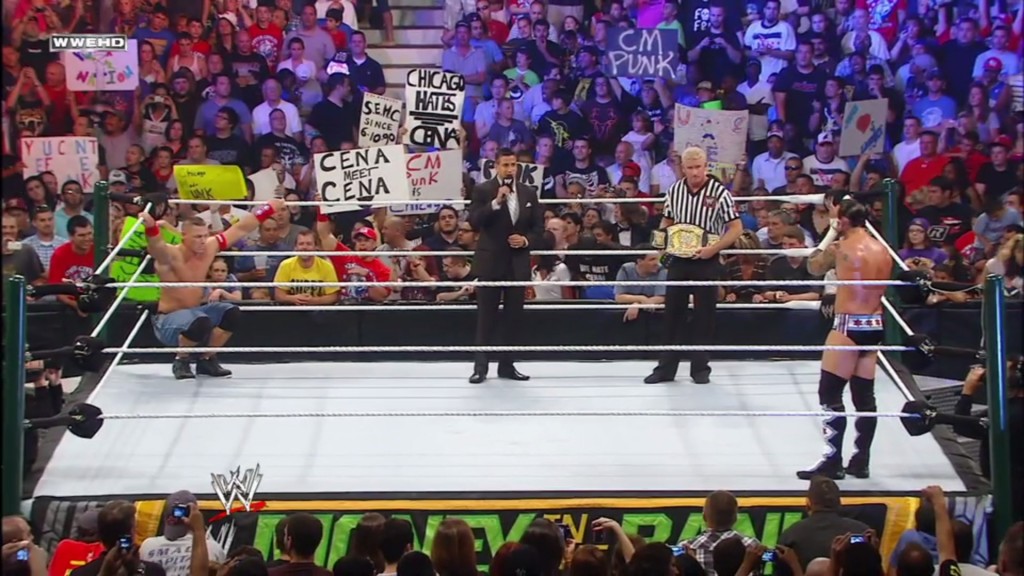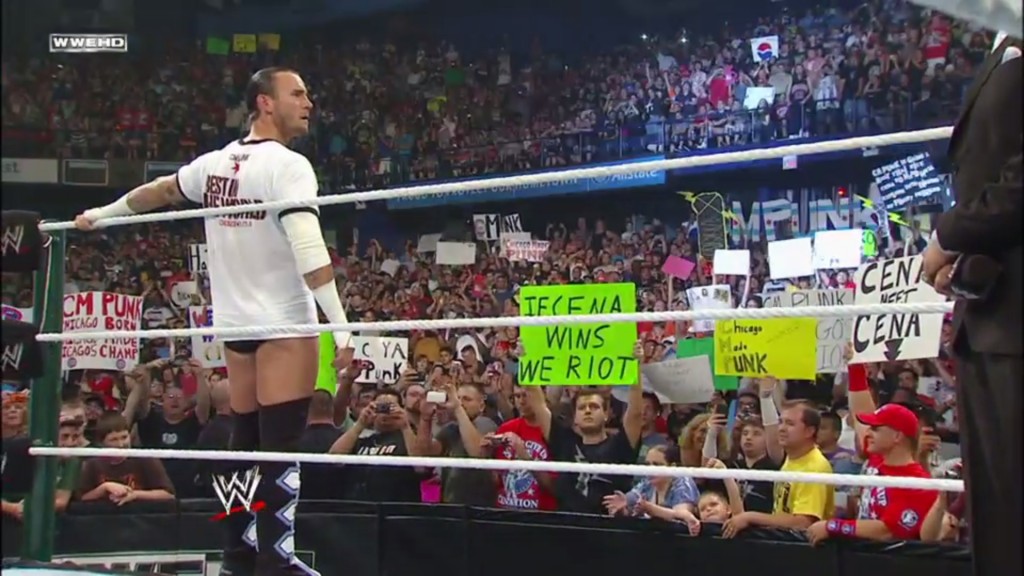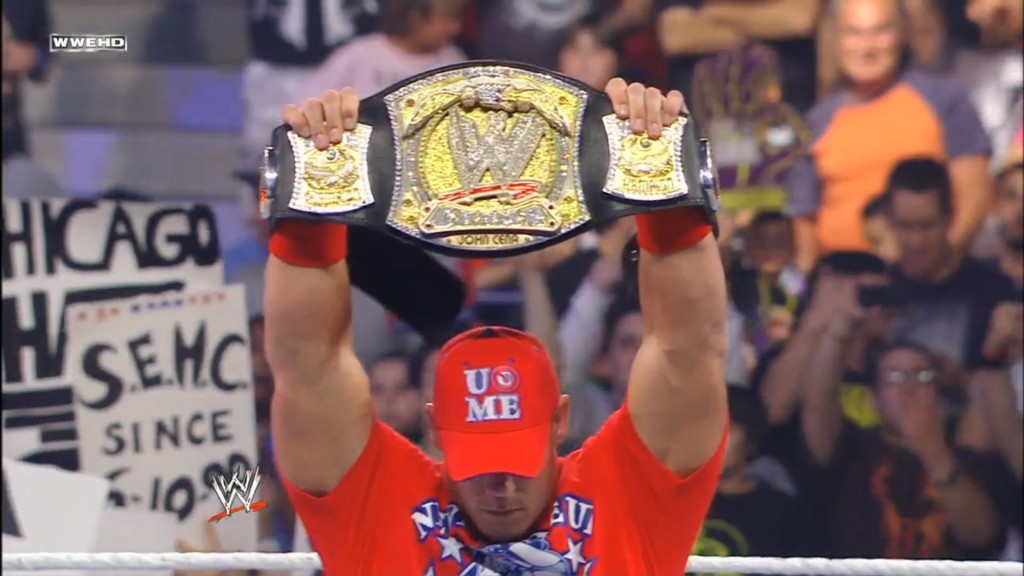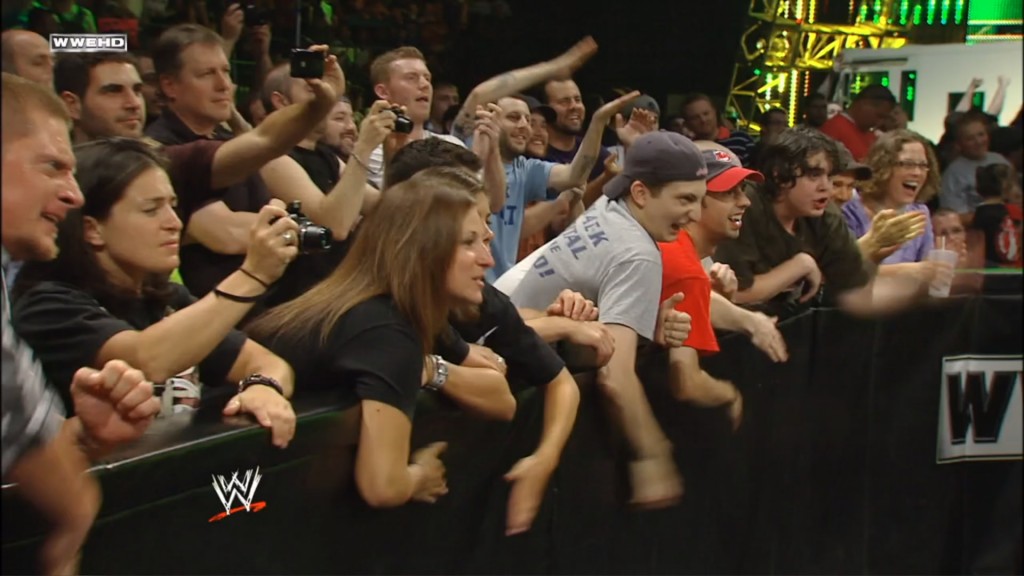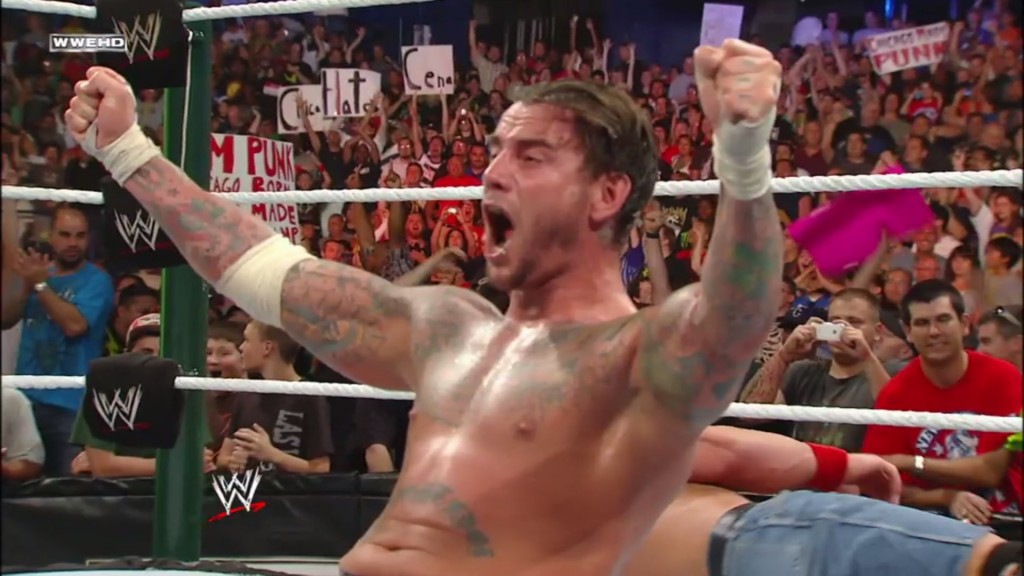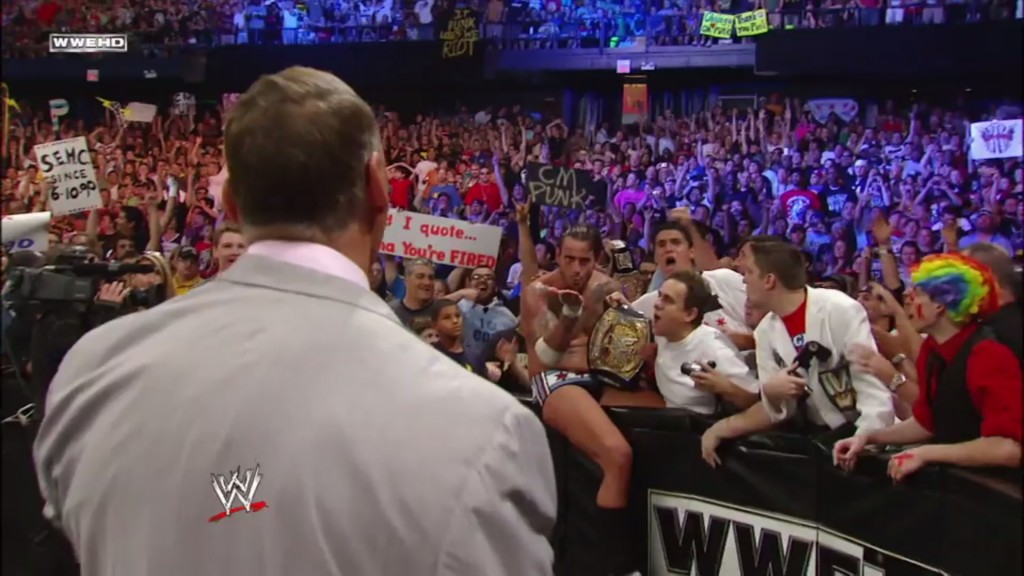Wrestling is Still Real To Me, Dammit!
The roar of the crowd is electrifying. Two men, as different from each other as could possibly be, stand eye to eye. One is a clean faced, crew-cut sporting, ultimate good guy. The other is a tattoo covered, egotistical, loner… And this partisan crowd is firmly behind him. This is the moment they’ve all been waiting for. This is the moment both athletes have been waiting for. Live in front of 14,815 people and millions watching at home, these men are about to do battle for the most coveted prize in the business. When all is said and done, they will have put on one of the most memorable matches in years. The crowd doesn’t know it yet, but boy can they feel it. This is wrestling. And I'm a fan. I don’t mean to overplay the significance of admitting this, but it does seem like being an adult fan of wrestling is still a taboo thing. Many regard it to be for kids at best, and, to be fair, I did first start watching wrestling as a kid, but there are far more reasons beyond nostalgia that I continue to be a fan. As an adult, I’ve become more interested in the business side of things, and am genuinely fascinated by stories about how wrestling has evolved over the years. However, there is still nothing that compares to the feeling I get when I witness something truly memorable in the ring. The backstage stories are fascinating but the moments that truly make me feel like a fan still happen within the squared circle itself. One such moment happened on July 17th, 2011 when the reigning WWE Champion, John Cena, faced off against his archrival CM Punk.
The History
Wrestling is an ongoing train, never really taking a break. Characters have histories that stretch years upon years, so it can be difficult to boil things down without simplifying them, but let’s try anyway. In the summer of 2011, wrestling was admittedly feeling a little stale. Long gone were the ‘attitude-era’ days of the 1990s when wrestling was at its hottest with men like Stone Cold Steve Austin and The Rock leading the charge. The wealth of talent and clashing personalities made for explosive and unpredictable television. On top of that, WWE (WWF at the time), was competing head-to-head with another promotion, WCW, in a rivalry that enticed everyone to try and be the best. When WCW went out of business in 2001, that dynamic disappeared along with any sign of a true competitor to WWE.
Fast forward to 2011 and there was only one man at the top, John Cena. Here was a man who, despite his unorthodox wrestling attire of jean shorts (jorts?), looked like a stereotypical good guy of the Hulk Hogan ‘say your prayers and eat your vitamins’- vein. Clean-cut and muscle-bound, Cena was nearly unstoppable. Despite being labeled an ‘underdog,’ Cena barely ever lost cleanly and a lot of fans started to get sick of him for this reason. He was still being promoted as a face, a wrestling term for a ‘good guy,’ but many in the crowd booed him simply because they were tired of him. It became common place to hear one half of the crowd chanting “let’s go, Cena,” while the other half responded with “Cena sucks!” To be fair, this isn't totally Cena’s fault. The guy is truly a workhorse, not only inside the ring but outside of it too, having completed a record 450+ wishes for the Make a Wish foundation. Regardless, his character was stale, and the creative team was putting too much focus on Cena at the expense of other talented wrestlers. Wrestlers like CM Punk.
While Cena was beloved by kids, CM Punk was the guy that adults loved. Here was a guy that didn’t look like the stereotypical wrestler. Rather than being muscle-bound, Punk was lean. Rather than being a clean-looking guy, Punk was covered in tattoos. He had a look that was truly his, but he also had a unique identity. CM Punk is straight-edge, which means he doesn’t drink and he doesn’t do drugs. Depending on whether he was a face or a heel (bad guy), Punk would use that part of his identity to either highlight his thirst for competition, or as a clear example of why he was better than everyone else. Punk understood how to work the crowd and had the ability to whip people into a frenzy. Even better, he could back up his talk in the ring, being not only an excellent technical wrestler, but a great in-ring story teller as well. Despite often wrestling as a heel, Punk was cheered by many adult fans simply out of respect for the man. In many ways, he was the anti-Cena.
The best wrestling characters are those when the wrestler takes their real-life personality and dials it up by another 10 or 20%. This is true of Cena and it’s true of CM Punk. Furthermore, and perhaps ironically so, in a business that’s often ignorantly labeled as ‘fake,’ the best stuff comes out of exaggerating reality. This is what made the summer of 2011 one of the most memorable ones in the history of wrestling.
At the time, despite being loved and appreciated by many fans, CM Punk had never really been the top guy. He had held many championship belts by this point, but there was still a lingering feeling that he was being overlooked by the company and the powers that be. Other people were being pushed ahead of Punk who felt that he wasn’t getting the opportunities that he deserved. This resentment and bitterness about being mistreated was leading Punk towards declining to re-sign with the WWE when his contract was supposed to end that summer. This is all true, and it’s important to know because of what would happen next. On the night that CM Punk’s contract was set to expire, he would be facing John Cena at the Money in the Bank pay-per-view for Cena’s WWE Championship. A few weeks before the event, Punk was given a microphone to air his issues on live television, and the rest is history.
The Build-Up
On June 27th, 2011, CM Punk sat cross-legged on the stage and started his promo: “I have a lot of things I wanna get off my chest.” From there, Punk would go on to deliver a groundbreaking promo where he broke the fourth wall, mentioned wrestlers and promotions not affiliated with the WWE (including his long-time friend and fellow wrestler, Colt Cabana), openly criticized several top backstage personnel, and basically aired all of his resentment and bitterness about being held back. It was groundbreaking because Punk was talking about aspects of the business that were never really discussed on air. The line between fiction and reality was as blurred as it had ever been, and it made for one of the most talked about promos in years. For many fans and even fellow wrestlers, Punk was saying things that they had been feeling for years.
The promo kickstarted the feud, and had even long-time fans questioning how much of what they were seeing was fact versus fiction. It’s difficult to overestimate how groundbreaking the promo was. It felt incredibly real. Punk didn’t even go out there wearing a CM Punk shirt, instead choosing to don a Stone Cold Steve Austin shirt, who was the ultimate anti-authority figure in wrestling. Most wrestlers would rather promote their own gear, so putting on another wrestler’s shirt made it seem like Punk really didn’t care anymore. He was a ticking time-bomb, and it made wrestling feel unpredictable for the first time in years. With such a hot build-up, anticipation was high for the title match at WWE’s Money in the Bank pay-per-view event. Would this really be CM Punk’s final match at WWE? Would the writers have John Cena completely humiliate CM Punk? Would Cena, the ‘underdog,’ emerge victorious yet again? Or would CM Punk beat John Cena and bring about change in an environment that had become stale?
The Match
Money in the Bank 2011 was in Chicago, Illinois. It’s well known that there are several venues and cities that wrestlers particularly love performing in because the crowds there are always hot. MadisonSquareGarden is one of them and so is Chicago, but Chicago was especially relevant here because CM Punk is from Chicago, and he’s never been shy about his love for that city. Some even speculate that the ‘CM’ in his name stands for ‘Chicago-Made.’ As a result, despite Punk being a heel walking into Money in the Bank, he was a hero in front of his hometown crowd.
Even before his entrance music hit, the crowd of roughly 14,000 was chanting his name and they would only get wilder when the man himself came out clad in the colors of Chicago. It’s difficult to put into words the atmosphere leading up into that match. It felt dangerous, like they really would riot if CM Punk lost. When Cena, the face, came out, it felt like the entire arena was booing him. Cena did none of his usual theatrics, declining to salute the crowd as he usually would. Instead, he walked straight to the ring, holding his championship belt in the air, head-down.
The match itself starts off slow, but it’s done on purpose. Everyone watching the match was desperate to see how this whole thing would end, and the wrestlers milked that for everything it was worth, building the tension at a steady pace. They start off feeling each other out, chain wrestling from one rest hold to another, letting the crowd get hotter and hotter with anticipation. At one point early in the match, some members of the audience started a familiar “you can’t wrestle” chant aimed at Cena. Rather than ignore it, CM Punk playfully mimes to the crowd ‘me? Or him?’ before answering with an ‘oh, ok!’ It’s a small example, but a clear one nonetheless of how well these wrestlers paid attention to the audience during the course of this match. Later in the match, Cena is indicating that he’s about to go for a signature move of his, and the crowd responds by booing loudly. Cena, looking out at the hostile crowd, gives them a shrug as if to indicate that he knows he’s not going to win them over, at least not tonight.
Crowd control, for lack of a better term, is one of the aspects of pro-wrestling that’s often overlooked. It takes real skill to manipulate a crowd to the extent that they’re responding to every little action that happens in the ring, which makes the action not only more satisfying to the wrestlers themselves but to the entire audience. For this match, it felt like the crowd never went completely silent, a steady buzz serving as background noise throughout the match punctuated often by cheers, boos, and other legitimately emotional reactions. A hot crowd can make a great match into a classic.
As the match progressed, there would be an increasingly steady stream of sudden action filled with reversals and high-impact moves, but the wrestlers continued going back to the rest holds, giving the crowd time to appreciate each individual detail of the match. For most of the match, neither man proves to be particularly dominant until Cena locks in his signature STF submission maneuver. The thing about signature moves and finishing moves is that they’re usually used as ways to end a match. As a result, whenever one does happen, especially in such a high-pressure match like this, the crowd almost jumps out of their seat, desperate to see whether this is the end. Great wrestlers know how to milk this without going to the well too many times. When Cena locked in the STF for the first time, many assumed that Punk wouldn’t submit there, which he didn’t, making it to the ropes that requires a break in the hold. Soon after, Cena attempts to go for his Attitude Adjustment finisher. Punk counters, going for his own G.T.S (Go To Sleep) finisher, but then Cena counters again before finally locking in the STF once more. This time, Punk almost makes it to the rope but Cena pulls him back to the center of the ring, making it seem even more likely that Punk might actually tap out this time. Instead, he suddenly counters it into his own Anaconda Vise submission move, and the crowd goes nuts, begging Cena to tap out. Somehow, Cena holds on, gets to his feet, and hits a massive Attitude Adjustment out of nowhere. He quickly goes for the cover attempting to get the 3-count for the win…
But Punk kicks out at 2! It’s not over yet. During the match, both wrestlers made several unsuccessful attempts to hit their respective finishers, so when one of them finally does get it, it’s a good indicator that the match could be over, though in such a high profile contest like this, it wasn’t a huge surprise to see Punk kick out. Moments afterwards, Cena surprisingly manages to hit yet another AA at which point many assume that the match is over, but Punk kicks out again. The tension continues to build to the point where Punk finally hits his own finisher, but he also inadvertently knocks Cena out of the ring. Knowing he can only pin Cena inside of the ring, Punk goes to fetch Cena at which point the owner of the WWE, Vince McMahon makes an appearance.
The build-up to the match had emphasized that Mr. McMahon needed Punk to re-sign or lose the match. Storyline wise, Punk had yet to do either, so the crowd sensed something was up when he made his appearance. During the 1990s, there was a real-life situation where the WWE’s Champion at the time, Bret Hart, was about to head over to WCW, but was unwilling to drop the title to McMahon’s competitor of choice due to personal reasons. As a result, when Bret Hart was locked in a submission move, McMahon had the referee signal that the match was over even though Bret didn’t actually submit. This moment was infamous, because Bret Hart had no idea that this was going to happen. He wasn’t supposed to lose that night, and he literally spat in Vince’s face.
After rolling Cena into the ring, Punk would have an intense stare-off with McMahon, giving Cena time to recover. Once he got back into the ring, he walked right into the STF submission move, at which point, Vince tried to get the referee to ring the bell, referencing the real-life Bret Hart screw job. Cena stops it, tells Vince “not this way,” and walks right into CM Punk’s G.T.S. finishing move. Punk goes for the cover and it’s over. CM Punk wins!
This was a match that felt real because, in a way, it was. Let me clarify. Wrestling is scripted, but it’s not fake. Despite precautions, the moves hurt and legit injuries happen. The toll that it takes on the performers’ bodies can not be overestimated, but the wrestlers still go out there because they love the business, and that is the thing I love most about wrestling. If you had to sum up wrestling with one word, it would be passion. You have to be passionate about this business in order to go through the mental and physical pain that these men go through to entertain the fans, and we love them for it. That’s why we get excited when one of our favorites wins the world championship, because it means that the company sees the same thing we see: that man is one of the best in the world. It’s like a lifetime achievement award every time you win it.
Money in the Bank 2011 was wrestling at its best. It was reality exaggerated to dramatic effect. It was about passion. It was about the passion CM Punk had for the business. It was about the passion John Cena had for the business. It was about the passion the crowd had for CM Punk. And it was about CM Punk finally being rewarded for that passion. After a tense 40 minutes, the match would end with several false finishes including a reference to a notorious incident. Most importantly, it would end with CM Punk victorious, beating the unbeatable John Cena cleanly in the middle of the ring. Punk would grab his WWE title, blow Vince McMahon a sarcastic kiss goodbye, and then run into the crowd, holding his title high in the air amongst his hometown followers. After a build-up where reality was blurred, Money in the Bank ended with a feel-good moment when, ironically, the ‘bad guy’ was the most loved guy in the business.
